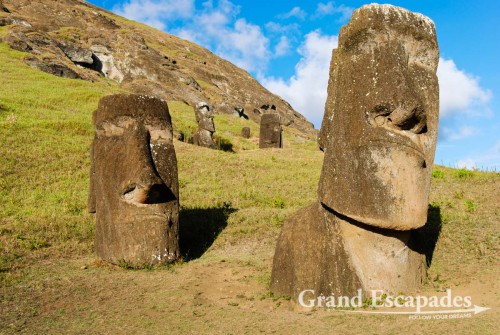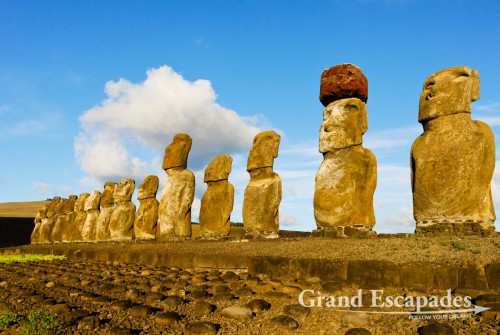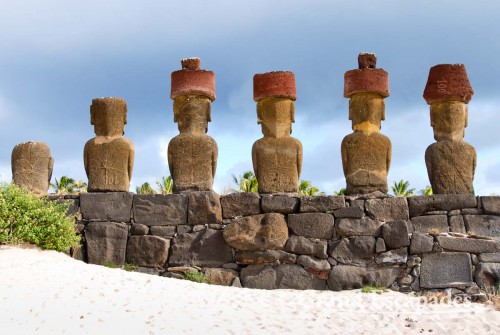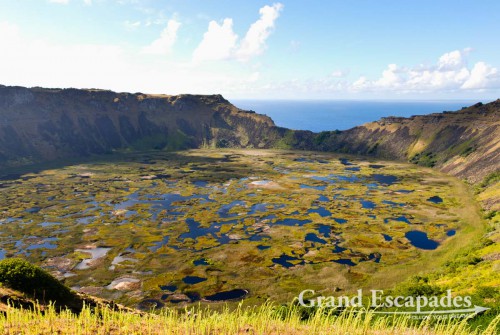
Rano Raraku, the quarry where all the Moais were carved from the volcanic stone, Rapa Nui or Easter Island, Pacific
After a few days on Rapa Nui, it was time to visit what we had actually come to see, the legendary Moai. There are many places where these amazing statues that seem to stare into the distance can be found, but five locations are truly spectacular.
Ahu Tahai is only a short hike from the village with three restored Ahu, as the platforms that support the Moai are called. There you can see a Moai whose eyes were replaced, the only one on the island. To visit all other sites, you need to be more mobile. We tried our luck with various agencies, in vain. On a weekend during the high season plus the Queen Elisabeth calling port, the place was cleaned out of rental cars. Luckily, we finally managed to rent a quad for two days.
Riding our new toy, we set out to Rano Raraku in the east of Rapa Nui, the quarry where all the Moai were carved from the volcanic stone. We wandered through the amazing setting of semi-finished and half buried statues scattered around the green slope of this volcano. It was dead quiet and the sun was setting on their distinct stony faces. One of the heads was tilted like trying to catch the last ray of the disappearing sun. Having this mystic place only for us was an unforgettable moment, equaling watching the sunrise over Machu Picchu.

Rano Raraku, the quarry where all the Moai were carved from the volcanic stone – Here the biggest Moai ever built, 21 meters high, Rapa Nui or Easter Island, Pacific

Rano Raraku, the quarry where all the Moais were carved from the volcanic stone, Rapa Nui or Easter Island, Pacific

Rano Raraku, the quarry where all the Moais were carved from the volcanic stone, Rapa Nui or Easter Island, Pacific
Then we went over to Ahu Tongariki, right next to the volcano with no less than 15 Moai lined up on the largest Ahu ever built. A Tsunami in 1960 caused a lot of damage but a Japanese company financed the restoration of this ancient ceremonial site in 1990.
Ahu Akivi, in the middle of the island, is particularly special because its seven Moai are the only ones that face the sea. But as all Moai, they overlook the site of an ancient village.

Ahu Akivi is special because its 7 Moai are the only ones that face the sea, Rapa Nui or Easter Island, Pacific
In the far north of the island, Ahu Nau Nau features the perfectly chiseled faces of five Moai with a white sandy beach as a backdrop and palm trees all around it. We guess this description needs no further commenting! A hundred meters away from it is Ahu Atue Huki, a single Moai that the anthropologist Thor Heyerdhal and a group of islanders propped up in nine days without any help of modern day machinery.
Last but not least, we visited the other star attraction of Rapa Nui, the Orongo Ceremonial Village up on rim of the crater of volcano Ranu Kau, in the southernmost part of the island. This was the place of a ceremony that became known as the “Birdman Cult”. A few houses made of flat pieces of stone, where the men lived during that ceremony, have been restored. There, the leaders of all clans met each year. The main goal was to retrieve the first egg of a certain bird that nested on a tiny island just off the cliffs. Whoever got the first egg and brought it back to the ceremonial village was considered the leader for that year. This culture initially ran partly parallel to the Moai culture, but later on replaced it.
However, the main attraction is the sweeping view from the crater rim. The lagoon inside the crater looks like a swamp, intercepted by tiny patches of grass, while the steep slopes of the crater are covered with very green grass. All this with the ocean in the background, we can very well understand why this place was chosen to for this annual meeting.











No comments yet.